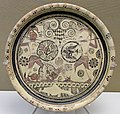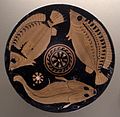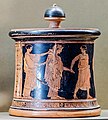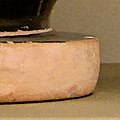Typology of Greek vase shapes
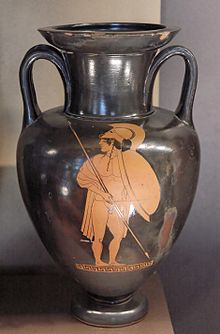

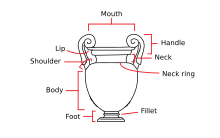
Thepottery of ancient Greecehas a long history and the form ofGreek vase shapeshas had a continuous evolution fromMinoan potterydown to theHellenistic period.AsGisela Richterputs it, the forms of these vases (by convention the term "vase" has a very broad meaning in the field, covering anything that is a vessel of some sort) find their "happiest expression" in the 5th and 6th centuries BC, yet it has been possible to date vases thanks to the variation in a form’s shape over time, a fact particularly useful when dating unpainted or plain black-gloss ware.
The task of naming Greek vase shapes is by no means a straightforward one. The endeavour by archaeologists to match vase forms with those names that have come down to us from Greek literature began withTheodor Panofka’s 1829 bookRecherches sur les veritables noms des vases grecs,whose confident assertion that he had rediscovered the ancient nomenclature was quickly disputed by Gerhard and Letronne.
A few surviving vases were labelled with their names in antiquity; these included ahydriadepicted on theFrançois Vaseand akylixthat declares, “I am the decoratedkylixof lovely Phito” (BM, B450). Vases in use are sometimes depicted in paintings on vases, which can help scholars interpret written descriptions. Much of our written information about Greek pots come from such late writers asAthenaiosandPolluxand other lexicographers who described vases unknown to them, and their accounts are often contradictory or confused. With those caveats, the names of Greek vases are fairly well settled, even if such names are a matter of convention rather than historical fact.
The following vases are mostly Attic, from the 5th and 6th centuries, and follow theBeazleynaming convention. Many shapes derive from metal vessels, especially in silver, which survive in far smaller numbers. Some pottery vases were probably intended as cheaper substitutes for these, either for use or to be placed asgrave goods.Some terms, especially among the types ofkylixor drinking cup, combine a shape and a type or location of decoration, as in theband cup,eye cupand others. Some terms are defined by function as much as shape, such as thearyballos,which later potters turned into all sorts of fancy novelty shapes.
Overview
[edit]Greek pottery may be divided into four broad categories, given here with common types:[1]
- storage and transport vessels, including theamphora,pithos,pelike,hydria,stamnos,pyxis,
- mi xing vessels, mainly forsymposiaor male drinking parties, including thekrater,dinos,andkyathos,
- jugs and cups, several types ofkylixalso just called cups,kantharos,phiale,skyphos,rhyton,mastos,and jug-typesoinochoeandloutrophoros,
- vases for oils, perfumes and cosmetics, including the largelekythos,and the smallaryballos,alabastron,andaskos.
In addition, various standard types might be used as external grave-markers (in extra-large versions, sometimes in stone), funeraryurnscontaining ashes, or asgrave goods.Several types of vase, especially the taller ones, could be made in "plastic" forms (also called "figure vases" or "relief vases" ) where the body was shaped sculpturally (somewhat in the manner of the modernToby jug), typically to form a human head.
Vase shapes
[edit]- Storage
-
Amphoratype A, c. 520 BC.
-
Amphora type B.
-
Amphora type C.
-
Neck amphora,c. 520 BC.
-
Belly amphora,with hardly a distinct neck
-
Ovoid neck amphora
-
Nikosthenic amphora,c. 530 BC.
-
Panathenaic amphora,always large
-
Pseudo-panathenaic amphora, c. 500 BC.
-
Pointed amphora
-
Transport amphorae
-
Hydria-black figure type
-
Hydria-red figure type orKalpis
-
Lebes Gamikos,for weddings, c. 340 BC
-
Stamnos,c. 480–470 BC.
- Cups
-
Kantharostype A
-
Kantharos type B
-
Kylixtype A
-
Kylix type B
-
Band cup,with the main painting in a band low on the body. All these "cups" are covered bykylix
-
Eye-cup,painted with eyes
-
Komast cup,Athenian black-figure, with short stem, angled "offset" lip.[2]
-
Lip cup,with the main painting just below the lip; the stem and footr are lost in this example
-
Merrythought cup,with distinctive "wishbone" handles
-
Mastos,breast-shaped cup with pointed nipple base; handles optional
-
Mastoid cup,like a mastos but with flat base and often handles
-
Rhyton,c. 430 BCE.
-
Skyphos,c. 740 BC
-
Glauxskyphos
-
Hermogenes skyphos
- Jugs
-
OenochoeShape 1
-
Oinochoe Shape 2
-
Oinochoe Shape 3
-
Oinochoe Shape 7
- Small oil and perfume
-
Alabastron,small holders for oil or perfume
-
PyriformAryballos
-
Globular aryballos
-
Fancy aryballos in the form of threecockle shells,6th century BC
-
Acornlekythos
-
Deianeira lekythos, c. 550 BC.
-
Shoulder or secondary lekythos, c. 500 BC.
-
Standard or cylinderlekythosc.490 BCE.
-
Squat lekythos
-
"Huge"Loutrophoros,330 BC
- Other
-
Lekanis
-
Nestoris(Trozella)
-
Pinax(plaque)
-
Phormiskos(here a terracotta model)
-
Plate
-
Pyxis,c. 470 BC.
-
Pointed pyxis
Styles of lips and feet
[edit]- Lip styles
-
Flaring lip
-
Inverted Echinus lip
-
Lip in several degrees
-
Torus lip
- Foot styles
-
Disk foot
-
Echinus foot
See also
[edit]- Ancient Greek art
- Black-figure pottery
- Red-figure pottery
- Greek terracotta figurines
- List of Greek Vase Painters
Notes
[edit]- ^Woodford, 12-14;"Shapes" (see menu at left),Beazley Archive, Oxford
- ^Beazley, Cups
- ^Beazley, Cups
References
[edit]- Gisela M. A. Richter, Marjorie J. Milne,Shapes and Names of Athenian Vases,Metropolitan Museum of art, New York, 1935.
Further reading
[edit]- Von Bothmer, Dietrich (1987).Greek vase painting.New York: The Metropolitan Museum of Art.ISBN0870990845.




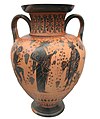







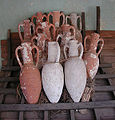







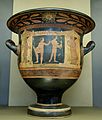

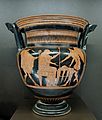











![Komast cup, Athenian black-figure, with short stem, angled "offset" lip.[2]](https://upload.wikimedia.org/wikipedia/commons/thumb/2/23/Komast_cup_Louvre_E742.jpg/120px-Komast_cup_Louvre_E742.jpg)


![Siana cup, Similar to Komast, with slightly longer stem, and painted on the inside.[3]](https://upload.wikimedia.org/wikipedia/commons/thumb/6/6c/Siana_cup_Louvre_F67.jpg/120px-Siana_cup_Louvre_F67.jpg)


































